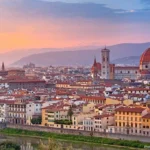
Hanoi, the vibrant capital of Vietnam, is a city steeped in history, culture, and significance. With its roots dating back over a thousand years, Hanoi has evolved into a bustling metropolis, offering a unique blend of tradition and modernity. As we delve into 25 intriguing historical facts and numerical trivia about Hanoi, we’ll uncover the city’s rich heritage, iconic landmarks, and the numerical details that make it a remarkable place on the world map. From its founding as Thang Long to its role during the Vietnam War, from architectural marvels to culinary delights, this exploration sheds light on the heart and soul of Hanoi, where the past and present seamlessly coexist.
Founding of Thang Long: Hanoi’s history can be traced back to the year 1010 when Emperor Ly Thai To decided to move the capital of the newly-formed Ly Dynasty from Hoa Lu to a more strategic location. This marked the official founding of the city under the name “Thang Long,” which means “Ascending Dragon.” The decision to establish the capital here was based on the belief that a dragon had risen from the Red River, a powerful symbol in Vietnamese culture. Thang Long thrived as a political, economic, and cultural center over the centuries.
Name Change to Hanoi: In 1831, the city’s name was changed from Thang Long to Hanoi, symbolizing its location between the Red River (Hong) and the Black River (Da). This change occurred during the Nguyen Dynasty, as part of the effort to strengthen control over northern Vietnam.
Geographical Size: Hanoi’s geographical area covers approximately 3,358 square kilometers, making it one of the largest cities in Vietnam. This sprawling area encompasses not only the urban center but also suburban districts, farmlands, and rural communities.
Hoan Kiem Lake: Hoan Kiem Lake, often referred to as the “Lake of the Restored Sword,” is a central and iconic feature of Hanoi. It spans approximately 12 hectares and is surrounded by picturesque parks, historic temples, and a bustling urban environment. The lake is a popular gathering spot for both locals and tourists and is associated with several legends and historical events.
Population of Hanoi: As of 2022, Hanoi is estimated to be home to over 8 million people. This high population density reflects the city’s status as the capital and its role as a major economic and cultural hub in Vietnam.
The Old Quarter: Hanoi’s Old Quarter, also known as “36 Pho Phuong” (36 Streets and Guilds), is a historical trading district that dates back to the 13th century. It’s known for its maze of narrow streets, each traditionally dedicated to a specific trade or craft. This area is rich in history, and its architecture and layout have been preserved, offering a glimpse into Hanoi’s past.
Vietnam War Capital: During the Vietnam War, Hanoi served as the capital of North Vietnam. The city endured heavy bombing by the U.S. between 1965 and 1972, which left a lasting impact on its infrastructure and people. Key war-related sites, such as the Hoa Lo Prison (Hanoi Hilton) and museums, offer insight into this period.
Capital After the Geneva Accords: The Geneva Accords of 1954 marked the end of the First Indochina War and divided Vietnam into two separate states, North and South Vietnam. Following these accords, Hanoi officially became the capital of a unified Vietnam on October 10, 1954, as the Democratic Republic of Vietnam, or North Vietnam.
Ho Chi Minh Mausoleum: The Ho Chi Minh Mausoleum in Hanoi is an imposing structure where the embalmed body of Ho Chi Minh, the leader of the Vietnamese communist revolution, is displayed. It was inaugurated on August 29, 1975, two years after Ho Chi Minh’s death. The mausoleum is an important symbol of the nation and a place of pilgrimage for Vietnamese people and international visitors.
One Pillar Pagoda: The One Pillar Pagoda, or Chua Mot Cot, is a unique architectural masterpiece. It was constructed in 1049 during the reign of Emperor Ly Thai Tong. The pagoda stands on a single stone pillar rising from a pond, resembling a lotus blossom, and it’s often considered a symbol of purity and strength in Buddhism. This pagoda is not only a religious site but also an architectural marvel, demonstrating the artistic and spiritual heritage of Hanoi.
Flag Tower of Hanoi: The Flag Tower of Hanoi, also known as Cột cờ Hà Nội, is an iconic structure located in the heart of the city. This historical monument was built in 1812 during the Nguyen Dynasty. It stands at a towering height of 33.4 meters and has a base diameter of 41 meters. The tower has been a symbol of Hanoi’s strength and resilience throughout its history and has witnessed significant moments in the city’s past.
Districts of Hanoi: Hanoi is divided into 18 districts, each with its own unique character and role in the city’s administration. The districts range from the bustling urban centers of Ba Dinh and Hoan Kiem to the more suburban and rural districts on the outskirts of the city. Ba Dinh District, in particular, is significant as it houses important government buildings, making it the political center of Vietnam.
Temple of Literature: The Temple of Literature, or Van Mieu-Quoc Tu Giam, is a revered historical and cultural site in Hanoi. It was founded in 1070 by Emperor Ly Thanh Tong and served as the first national university in Vietnam. The temple complex is dedicated to Confucius and his scholars, showcasing Vietnam’s deep-rooted appreciation for education and knowledge.
Climate of Hanoi: Hanoi experiences a tropical monsoon climate, characterized by distinct wet and dry seasons. The city’s average annual temperature hovers around 24°C (75°F). Summers are hot and humid, while winters can be cool, with occasional chilly spells. The climate has a significant impact on daily life, festivals, and the city’s vibrant street culture.
Long Bien Bridge: The Long Bien Bridge, initially built in 1903 by the French colonial authorities, is an engineering marvel in Hanoi. It spans the Red River, connecting the city to its northern suburbs. The bridge is approximately 1,700 meters long and has a unique combination of steel and stone elements. It played a crucial role during the Vietnam War, as it was frequently targeted by bombings and served as a lifeline between Hanoi and the northern regions.
Hanoi Opera House: The Hanoi Opera House, modeled after the Palais Garnier in Paris, is a stunning architectural gem in the city. Completed in 1911, it stands as a testament to the French colonial influence on Vietnam’s architecture. The opera house hosts various cultural events, including operas, classical concerts, and ballet performances, making it a hub for the city’s artistic and cultural scene.
Imperial Citadel of Thang Long: This UNESCO World Heritage Site, dating back to the 7th century, played a vital role in Hanoi’s history. It served as the political and cultural center for various Vietnamese dynasties and emperors. The ancient citadel, now partially excavated and preserved, provides valuable insights into Vietnam’s historical development and architecture.
Hanoi’s Street Food Culture: Hanoi is renowned for its vibrant street food culture, with countless food stalls and markets throughout the city. This culinary scene is characterized by dishes such as pho (noodle soup), bun cha (grilled pork with noodles), banh mi (Vietnamese sandwiches), and more. Street food vendors are an integral part of the city’s social fabric, offering delicious and affordable cuisine to locals and visitors alike.
Ceramic Mosaic Along the Red River: Hanoi is home to the world’s largest ceramic mosaic, stretching along the banks of the Red River for approximately 6.5 kilometers. This impressive piece of public art was created in 2010 to celebrate the city’s millennial anniversary. The mosaic features intricate designs and historical scenes, providing a visual narrative of Hanoi’s rich history.
Reunification Express: The Reunification Express is a historic train service in Vietnam that connects Hanoi in the north to Ho Chi Minh City in the south. This railway network, which began running in 1936, is named for the reunification of North and South Vietnam in 1976 after the Vietnam War. The train journey offers a scenic way to traverse the country, passing through diverse landscapes and cultural regions. It’s an enduring symbol of Vietnam’s unity and transportation heritage.
Hoa Lo Prison (Hanoi Hilton): Hoa Lo Prison, famously known as the “Hanoi Hilton,” is a historic site with a dark past. Initially constructed by the French colonialists in the late 19th century, it was used to detain political prisoners. During the Vietnam War, it gained international attention as a place where American prisoners of war (POWs) were held. The prison’s history is a stark reminder of the conflicts that Hanoi and its people have endured over the years, and it now serves as a museum.
Hanoi Stock Exchange (HNX): The Hanoi Stock Exchange (HNX) is one of the two main stock exchanges in Vietnam, the other being the Ho Chi Minh City Stock Exchange (HOSE). Established in 2005, HNX plays a crucial role in the country’s financial markets. It’s where securities, bonds, and other financial instruments are traded, contributing to Vietnam’s economic growth and development.
Water Puppetry: Hanoi is renowned for its vibrant water puppetry shows, a traditional art form that dates back to the 11th century. The unique performances take place on water stages, with wooden puppets manipulated by puppeteers hidden behind a screen. These shows often depict scenes from rural life, folklore, and history, providing an entertaining and culturally significant experience for both locals and tourists.
Pho Gia Truyen: Pho is an iconic Vietnamese dish, and Hanoi is home to Pho Gia Truyen, a restaurant celebrated for serving one of the best bowls of this delectable noodle soup. Established in the Old Quarter, Pho Gia Truyen is famous for its flavorful broth and fresh ingredients. It has become a must-visit destination for those seeking an authentic taste of Vietnam’s culinary heritage.
Hanoi International Film Festival (HANIFF): The Hanoi International Film Festival (HANIFF) is a significant event in the city’s cultural calendar. It provides a platform for showcasing films from various countries and promotes international cooperation in the film industry. HANIFF features a diverse selection of films, including international blockbusters, independent productions, and works by emerging filmmakers. It not only enriches Hanoi’s cultural landscape but also fosters cross-cultural understanding through the medium of cinema. The festival brings together film enthusiasts, directors, and actors from around the world, contributing to Hanoi’s status as a hub of artistic expression and global dialogue.
Hanoi FAQs
Here are some of the most commonly asked questions about Hanoi, along with detailed answers to help you plan your trip:
General
- Where is Hanoi? Hanoi is the capital of Vietnam, located in the northern part of the country on the western bank of the Red River, roughly 85 miles (140 kilometers) inland from the South China Sea.
- What does Hanoi mean? The name “Hanoi” literally translates to “Between Two Rivers,” referencing the Red River and smaller rivers that flow through the city and create its many lakes.
- What is Hanoi famous for? Hanoi is known for its rich history and culture, evident in its French colonial architecture, ancient temples, and bustling Old Quarter. It’s also a hub for delicious Vietnamese cuisine, water puppetry shows, and a vibrant nightlife scene.
Planning Your Trip
- Is Hanoi safe for tourists? Yes, Hanoi is generally considered safe for tourists. Petty theft can occur, but using common sense and keeping an eye on your belongings is advisable. Traffic can be chaotic, so exercise caution when crossing streets.
- What is the best time to visit Hanoi? The best time to visit Hanoi depends on your preferences. The weather is generally pleasant year-round, with warm and humid summers (April to October) and mild, dry winters (November to March). If you prefer cooler temperatures, avoid the hottest months (June to August).
- What currency is used in Hanoi? The Vietnamese Dong (VND) is the official currency in Hanoi. You can exchange your currency at banks or licensed money changers. Many restaurants and shops accept US Dollars, but the exchange rate might not be favorable. ATMs are widely available in the city.
Getting Around
- How do I get to Hanoi? Hanoi is served by Noi Bai International Airport (HAN), which has connections to major cities worldwide. Taxis, ride-sharing apps like Grab, and metered buses are available for transportation from the airport to the city center.
- How can I get around Hanoi? Taxis are a convenient way to get around, but agree on the fare beforehand or use a metered taxi. Ride-sharing apps are popular and affordable. Consider cycling, a fun way to explore the Old Quarter, but be cautious of traffic. Public buses are inexpensive but can be crowded.
Things to Do
- What are the must-see attractions in Hanoi? The must-see attractions in Hanoi include:
- Old Quarter: A maze of narrow streets lined with shops selling everything from traditional crafts to local food.
- Hoan Kiem Lake: A scenic lake in the city center, perfect for a stroll or a boat ride.
- Temple of Literature: A Confucian temple and university dating back to the 11th century.
- Ho Chi Minh Mausoleum: The final resting place of Ho Chi Minh, the revolutionary leader of Vietnam.
- Long Bien Bridge: A historic bridge designed by Gustave Eiffel, the same engineer behind the Eiffel Tower.
- Hoa Lo Prison (Hanoi Hilton): A former French colonial prison that held American POWs during the Vietnam War.
- What are some unique experiences in Hanoi?
- Water Puppet Shows: A traditional Vietnamese art form where puppets perform on water.
- Cooking Class: Learn how to prepare delicious Vietnamese dishes like pho, bun cha, and spring rolls.
- Cyclo Tour: Explore the city on a traditional Vietnamese pedicab.
- Day Trip to Ha Long Bay: Witness the stunning natural beauty of Ha Long Bay, a UNESCO World Heritage Site.
Food and Drink
- What is the best food to try in Hanoi? Hanoi is a haven for foodies. Here are some must-try dishes:
- Pho: A noodle soup with beef or chicken broth, rice noodles, and various meats and herbs.
- Bun Cha: Grilled pork served with vermicelli noodles, fresh herbs, and dipping sauce.
- Banh Mi: Vietnamese baguettes filled with savory ingredients like pate, grilled pork, and pickled vegetables.
- Nem: Spring rolls made with pork, rice noodles, and vegetables.
- Bun Bo Hue: A spicy noodle soup originating from Hue, known for its rich broth and thick rice noodles.
- What are some popular drinks in Hanoi? Vietnamese coffee, strong and served with condensed milk, is a local favorite. Fresh fruit juices and iced tea are refreshing options, especially on a hot day. Bia Hoi (fresh beer) is a popular and cheap local drink.
Culture and Customs
- What are some things to respect when visiting Hanoi? Dress modestly, especially when visiting temples or religious sites. It’s customary to take off your shoes when entering temples or pagodas.
- Bargaining is expected at markets and with street vendors. Start with an offer significantly lower than the asking price and negotiate politely.
- A wai (a slight bow with hands together) is a respectful greeting in Vietnamese culture. While not essential, it’s a nice gesture.
- Tipping is not widely expected in Hanoi, but it’s becoming more common in tourist areas. A small tip for good service is appreciated.
Language
- Do I need to speak Vietnamese to visit Hanoi? While speaking Vietnamese is not essential, learning a few basic phrases can go a long way. English is becoming more common in tourist areas, but knowing some Vietnamese shows respect for the local culture. Here are some helpful phrases:
- Xin chào (sin chao): Hello
- Cảm ơn (cam on): Thank you
- Không sao (khong sao): You’re welcome
- Bao nhiêu? (bao nhieu): How much?
- Ngon quá! (ngon qua!): Delicious!
Accommodation
- Where should I stay in Hanoi? Hanoi offers a variety of accommodation options, from budget hostels to luxury hotels. The best area for you depends on your preferences.
- Old Quarter: Immerse yourself in the heart of the action, but expect noise and crowds.
- Hoan Kiem Lake: Beautiful setting with a variety of hotels and restaurants.
- French Quarter: Elegant colonial architecture and a more upscale vibe.
- Is it safe to stay in Hanoi hostels? Hostels in Hanoi are generally safe, but as always, be mindful of your belongings. Choose a reputable hostel with good reviews.
Additional Tips
- Pack light, loose-fitting clothing suitable for hot and humid weather.
- Bring comfortable shoes for walking and exploring the city.
- Purchase a travel adapter with a Vietnamese plug for your electronic devices.
- Consider getting travel insurance to cover any unexpected events.
- Download a translation app to help you communicate with locals.
- Bargain politely when shopping at markets.
- Learn a few basic Vietnamese phrases. It goes a long way with locals.
- Be mindful of traffic when crossing streets.
- Drink bottled water to avoid getting sick.
By following these tips and FAQs, you can plan a fantastic and unforgettable trip to Hanoi!








